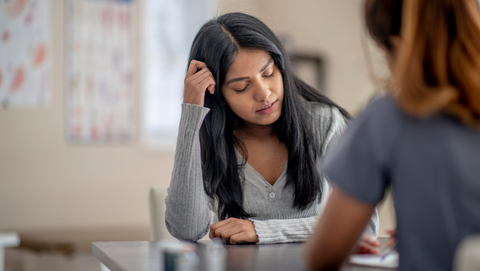Impact of Covid-19 on Teen Anxiety and Depression
By Tiffany Sanderson, Intern, and Christina Pay, Assistant Professor
Rates of teen anxiety and depression are on the rise; between 2003 and 2021, depression and anxiety rates in teenagers have skyrocketed from 5.4% to 20% of all U.S. teens experiencing symptoms. (Muiruri, 2021)
Covid-19 has impacted teens differently than adults because of the stage of development that teens are currently undergoing. While adults have experienced additional financial, social, and emotional pressure in their personal lives and at work, teens experience this pressure differently.
Adolescents with pre-existing mental health symptoms are even greater than those without symptoms prior to the Pandemic. The result of this may be caused by many factors such as lack of structured or daily routines, a decreased ability to access mental health services in school, lack of advanced emotional development, and physical isolation from peers (Jones, et al 2021).
During the Covid-19 Pandemic, many adolescents were required to forgo school dances, Prom, graduation, and other milestone activities of youth. Decreased face-to-face time spent with friends and family, as well as school and home confinement, have been determined to be individually associated with symptoms of increased depression and anxiety among teens. The conclusion of a study published by the Psychological Medicine Journal found that adolescents, particularly young females, experienced increased symptoms of anxiety and depression during the Covid-19 Pandemic within the United States (Hawes, et al 2021).
What teens want you to know about their mental health
It is important to remember that there may be factors that explain why teens do not seek help for their anxiety and depression symptoms. Adolescents may perceive barriers to getting help such as: making sense of their symptoms (unable to identify symptoms as anxiety because they do not fit a certain mold), difficulty confiding in others about their feelings/problems, feeling ambivalent to seeking help (a part of them wants help, a part of them doesn’t), and the role of others (parents and school counselors) in helping them seek professional help (Radez, 2022).
How you can help
Teens do not typically seek professional help on their own. The role of parents and adults in their lives who take a vested interest in their mental health and personal wellbeing is vital to the process of helping teens get help (Radez, 2022).
According to a study, conducted to determine adolescents’ perceived barriers to receiving treatment for their anxiety and depression symptoms, teens often worry about being perceived by adults as “attention seekers” and “weak” which means that they may refrain from sharing their symptoms in order to keep up appearances. This same concern with being perceived negatively also comes into play with the perception that adults have of their symptoms. Teens need to feel that adults view their symptoms as severe and in need of intervention in order to feel validated in those feelings. That means that by showing concern for your teen and their mental health, you have already begun the process of helping your teen to trust you with those feelings or thoughts that they are having. Families with limited access to mental health care can help their teen receive the care they need by contacting their teens’ school to coordinate at-school counseling as well as get access to other healthcare resources that are available (Radez, 2022).
Something that is important to remember is that your teen may not be ready to open up or get professional help. That is okay. It can be frustrating to watch a loved one refuse to get help, but with patience, love, and acceptance, they may eventually change their minds.
If your child has mentioned that they are harming themselves, that they would like to harm themselves, or others, please intervene and help them seek professional assistance as they may be at high risk for suicide. You can get help by calling the National Suicide Support Lifeline 1-800-273-TALK (8255). They can further connect you to resources in your community (SAMHSA).
References:
Hawes, M., Szenczy, A., Klein, D., Hajcak, G., & Nelson, B. (2021). Increases in depression and anxiety symptoms in adolescents and young adults during the COVID-19 pandemic. Psychological Medicine, 1-9. doi:10.1017/S0033291720005358
Help prevent suicide. SAMHSA. (n.d.). Retrieved June 27, 2022, from https://www.samhsa.gov/suicide
Jones, E. A. K., Mitra, A. K., & Bhuiyan, A. R. (2021). Impact of COVID-19 on Mental Health in Adolescents: A Systematic Review. International Journal of Environmental Research and Public Health, 18(5), 2470. MDPI AG. Retrieved from http://dx.doi.org/10.3390/ijerph18052470
Muiruri, M. F. G. (2021). How Cyber Activity Influences Depression and Anxiety in Teenagers.
Radez, J., Reardon, T., Creswell, C. et al. Adolescents’ perceived barriers and facilitators to seeking and accessing professional help for anxiety and depressive disorders: a qualitative interview study. Eur Child Adolesc Psychiatry 31, 891–907 (2022). https://doi.org/10.1007/s00787-020-01707-0


 Utah 4-H & Youth
Utah 4-H & Youth